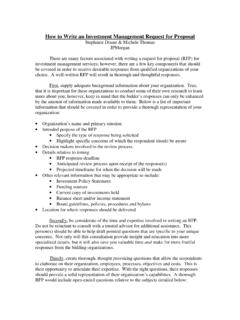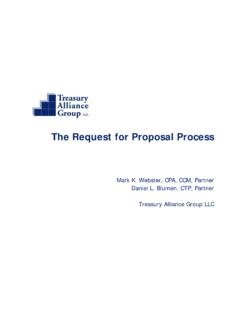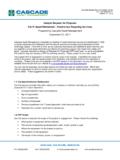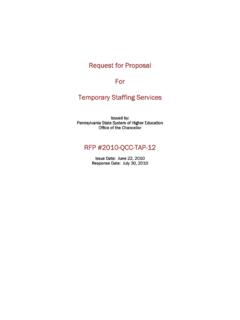Transcription of REQUEST FOR PROPOSAL (RFP): THE PROCESS
1 REQUEST FOR PROPOSAL (RFP): THE PROCESS Last Updated: 7/30/2008 1 REQUEST for PROPOSAL (RFP): The PROCESS A REQUEST for PROPOSAL (RFP) is a prospectus inviting consultants to apply for work on a specific project. An RFP outlines all the work and products required of a consultant and provides a means for evaluating the ability of various contractors to perform the required services. It is different from an open bidding PROCESS because an RFP is usually targeted to pre-selected potential contractors. Organizations should use this RFP PROCESS or a similar PROCESS when selecting vendors for services and/or consultants.
2 Below are the steps/topics you should consider in undertaking an RFP PROCESS : A. When Do You Need an RFP? An RFP is used to obtain services such as feasibility development strategies, studies, graphics, and design from outside specialists. An RFP is not usually used to obtain bids for purchasing supplies and materials. An RFP is used for work that requires expertise beyond what is available within an organization, and therefore the organization seeks to get the best product by soliciting proposals from several experts. B. Who Should Be Sent the RFP? The RFP should be sent to at least three consultants who are qualified to perform the work. It is important to discuss who will be sent the RFP with your SBS contract manager before you contact any proposed consultants.
3 In any event, the PROCESS must be open, and anyone wishing to respond to the RFP must be given the opportunity. C. Contacting Consultants After your SBS contract manager has approved who will receive the RFP, consultants are contacted to assure their interest in submitting a PROPOSAL . Once this is done, the RFP should be issued to all those who have indicated interest in responding. D. Responding to the RFP Allow the consultant sufficient time to respond to the RFP. The length of time can vary depending on the nature of the PROPOSAL . On average, three weeks is enough time to respond to an RFP. After the RFP is distributed, you may want to contact the consultants in order to set up a pre-submission conference.
4 The conference should occur one week after the consultants have received the RFP. 1. Pre-Submission Conference The purpose of the pre-submission conference is to discuss and clarify the project, scope of work and other details such as insurance requirements, the budget, billing procedures and Division of Labor Services requirements. E. Deadline for Submission As a general rule, the deadline for receipt of proposals should be within two to three weeks after the pre-submission conference is held, although time frames may vary according to specific projects. F. PROPOSAL Criteria Review Proposals are generally judged on the following criteria: 2 Quality of PROPOSAL : The PROPOSAL should be indicative of the type of work a consultant will do.
5 If a PROPOSAL is drawn up carefully and thoroughly, it is an indication the consultant is concerned about doing a good job. Track Record: The consultant should have completed similar studies or products (copies of these should be available for review if requested), preferably recently. Time: The consultant must have the ability to complete work within the requested time frame. Staff and Staff Resumes: The consultant should give names and backgrounds of those to be working on the project; resumes should also be included. Cost: The cost should be reasonable, and commensurate with the time, staff and production costs involved.
6 It should also be viewed in relation to the other submitted proposals. References: Other past completed contracts should be investigated to ensure a good working relationship was established with clients and that they were satisfied with the work performed. II. INFORMATION TO BE INCLUDED IN THE RFP A. Overall Scope of RFP When sent to the consultants, RFPs should be accompanied by a cover letter introducing the project (see Sample RFP Cover Letter). Certain information about the project, in addition to the description of services, must be transmitted. This can be included within the RFP itself, within the cover letter, or a combination of both. The consultant must be informed of the following: The type of professional service or product desired ( market analysis, feasibility study, graphic design and logos or promotional brochure).
7 The date proposals are due; whether there will be a mandatory pre-submission meeting, and if so, where and when; expected commencement of work and time performance. If appropriate, a map of the target area should be included with the RFP. An individual to whom the consultant can address questions prior to submission. The number of copies of the PROPOSAL required and where they should be sent. Deadlines for receipt of proposals. B. Specific RFP Format When sending the RFP to the consultant, the following must be included: Title Sheet:The title sheet should include the client's name, an indication of what the RFP will be used for and the deadline for submitting responses.
8 Introduction:The introduction briefly describes the project for which a consultant will be hired. It should give a concise background or history of the project describing its major components. Objectives: Define objectives and purposes of project as specifically as possible. Scope of Services: Identify the specific tasks that must be performed in order to achieve your stated objectives. Once the consultant is hired, the scope of services becomes the work guidelines. The scope of services should describe the parties involved, phasing (if any), expenses to be incurred. and the time schedule. It should clearly describe the relationship of the consultant's work to the project, who will use the work product, the specific audience to be addressed, and, especially, the purpose of the consultant s work.
9 The client should be clearly identified, including a brief account of the client s purpose, general scope of activity, and specific role in the project. III. CONSULTANT'S PROPOSAL The consultant's response to the RFP should include the following: 3A. Cover Letter This should be a very brief introduction to the project. It should act only as an introduction to the more in-depth sections discussed later in the PROPOSAL . B. Introduction/Summary of Work The most salient features of the PROPOSAL should be addressed in this section. The introduction or summary should cover all the major areas that the consultant will cover in his/her PROPOSAL . C. Scope of Services This is where the consultant's PROPOSAL should address the RFP in detail.
10 There should be a plan describing the consultant's approach to meeting each of the needs outlined in the RFP. The scope of services may include such items as maps, raw data, brief market or planning analysis, implementing strategies or preliminary drawings, designs or sketches. D. Proposed Timetable and Phasing This section should outline all work tasks and approximate completion dates. The timetable should include at least one mid-project review. E. Fee and Manning Schedule The fee and manning schedule can be described in one of two ways. The consultant can break down expenses by employee at their respective salary levels or by phases on a lump sum basis.

















